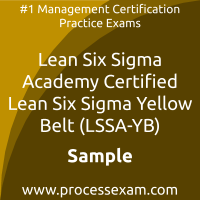 You have to pass the LSSA-YB exam to receive the certification from LSSA. To increase the effectiveness of your study and make you familiar with the actual exam pattern, we have prepared this LSSA Lean Six Sigma Yellow Belt sample questions. Our Sample LSSA Lean Six Sigma - Yellow Belt Practice Exam will give you more insight about both the type and the difficulty level of the questions on the LSSA Lean Six Sigma Yellow Belt exam.
You have to pass the LSSA-YB exam to receive the certification from LSSA. To increase the effectiveness of your study and make you familiar with the actual exam pattern, we have prepared this LSSA Lean Six Sigma Yellow Belt sample questions. Our Sample LSSA Lean Six Sigma - Yellow Belt Practice Exam will give you more insight about both the type and the difficulty level of the questions on the LSSA Lean Six Sigma Yellow Belt exam.
However, we are strongly recommending practice with our Premium Lean Six Sigma Academy Certified Lean Six Sigma Yellow Belt (LSSA-YB) Practice Exam to achieve the best score in your actual Lean Six Sigma Academy LSSA-YB Exam. The premium practice exam questions are more comprehensive, exam oriented, scenario-based and exact match of LSSA Lean Six Sigma - Yellow Belt exam questions.
LSSA Lean Six Sigma Yellow Belt Sample Questions:
Answers:
|
Question: 01 Answer: d |
Question: 02 Answer: a |
Question: 03 Answer: b |
Question: 04 Answer: a |
Question: 05 Answer: d |
|
Question: 06 Answer: c |
Question: 07 Answer: d |
Question: 08 Answer: b |
Question: 09 Answer: d |
Question: 10 Answer: a |
If you find any errors or typos in Lean Six Sigma Academy Certified Lean Six Sigma Yellow Belt (LSSA-YB) sample question-answers or online LSSA Lean Six Sigma Yellow Belt practice exam, please report them to us on feedback@processexam.com
